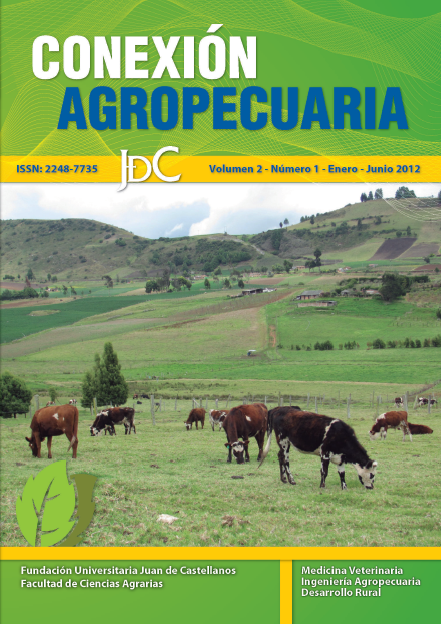Keywords:
Antibodies, fowl, prevalence, hemagglutination inhibition, surveillanceAbstract
Along the time, the poultry industry has become one of the pillars of the Colombian economy, as a result of its extensive influence in the national gross domestic product and in the livestock field. In fact, the poultry industry significantly contributes to the food security, due to the affordability of poultry and eggs in relation to other protein sources. Due to the current reality of greater economic integration and globalization, it is required to pursue the removal or reduction of barriers such as the health related ones, that could be an obstacle for free trade. The industrial-type poultry industry (broilers, layers, breeders, grandmothers, turkey) is one of the leading sectors of the country’s livestock production. Other types of exploitation such as the breeding of fighting cocks, backyard poultry, farm ostrich and quail, among others, represent another important part of this sector. However, a big concern related to these types of practices is the movement of birds and the potential risk of these as distributors of diseases that could potentially affect the national poultry industry. The Newcastle (ENC) is among the most important diseases. This is one of
the easily transmitted pathologies that causes great economic impact to the poultry industry due to its costs associated to high morbidity and mortality, low in production, high costs of treatment of secondary infections and significant investments in programs targeting its control and eradication. Therefore the objective of the study was to determine the presence of antibodies of the disease in fighting cocks (Gallus gallus) in Saboyá, Boyacá. The technique of hemagglutination inhibition was used for this matter. Prior to the study, a census was conducted to determine the population of (N = 1.500 animals). The health, manipulation and biosecurity standards of the subject population were assessed through the use of an epidemiological survey. The size of the
study sample which was n = 138 animals, was calculated through the use of the program Win episcope 2. The results found a prevalence of 96.4% (133 /138), with 79.7% (110 /138) in males and 20.3% (28/138) in females. The information obtained in the study will be included in the Agreement of Epidemiological Surveillance Program ICA FENAVI-FONAV. To prevent and control the spread of this disease, new measures such as the following ones need to be included: The implementation of vaccination programs not only to these birds, but also to the backyards where they have contact with, the development of plans for active epidemiological surveillance, the monitoring of suspicious cases, the creation of permanent trainings and education to owners, caretakers or
people dealing with these birds. These actions will make possible the removal of this disease in a near future.
Downloads
References
East I, Kite V, Daniels P & Garner G.(2006). A cross-sectional survey of Australian chicken farms to identify risk factors associated with seropositivy to Newcastle-disease virus. Preventive Vet Med 2006; (77):199-214.
ICA. (2009). Guía para la prevención, control y erradicación de la Enfermedad de Newcastle. [en línea],2009. Disponible en: http://www.ica.gov.co/getattachment/2595efa5-9885-4e7d-a15573aa79aa45eb/Newcastle.aspx
Lizarazo, C & Rodríguez, S. (2003). Seroprevalencia de la enfermedad de Newcastle por inhibición de hemaglutinación en aves de traspatio aledañas a explotaciones avícolas de tipo comercial en el departamento de Boyacá. Universidad Pedagógica y Tecnológica de Colombia. Tesis. Colombia 33 p.
Manual de la OIE sobre Animales Terrestres. (2008). Capítulo 2.3.14. Enfermedad de New Castle. p.8 Disponible en httt://www.oie.int/fileadmin/Home/esp/Health_standards/tahm/2.03.14.%Enfermedad%20de%20Newcastle.pdf
Nwanta A, Abdupa & Exema WS. (2008). Epidemiology, challenges and prospects for control of Newcastle disease in Village poultry in Nigeria. Worlds Poult Sci J; (64): 119-127.
Pinilla, J. & Rojas, Y. (2010). Seroprevalencia de la Enfermedad de Newcastle por Inhibición de la hemoaglutinación y ELISA, en aves de pelea en la ciudad de Tunja, (Boyacá). Universidad Pedagógica y Tecnológica de Colombia. Tesis. Colombia 12-38-50 p.
Romero, M. Narváez, S. & Sánchez J. (2009). Enfermedad de Newcastle en aves de traspatio del Eje Cafetero Colombiano. Universidad de Caldas, Facultad de Ciencias Agropecuarias, Programa de Medicina Veterinaria y Zootecnia, Departamento de Salud Animal. Disponible en: <http://www.scielo.unal.edu.co/scielo.php?script=sci_arttext&pid=S012202682009000200007&lng=es&nrm=iso>. Consultado:31/08/11
Tadesse, S. Ashenafi, H. & Aschalew Z. (2005). Seroprevalence study of Newcastle disease in local chickens in central Ethiopia. Intern J Appl Res Vet Med 2005; 3 (1): 25-29.





